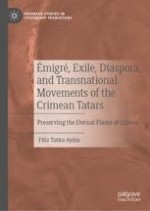2021 | OriginalPaper | Buchkapitel
5. Crimean Tatar Community in Turkey (1908–): From Émigré to Diaspora Nationalism
verfasst von : Filiz Tutku Aydın
Erschienen in: Émigré, Exile, Diaspora, and Transnational Movements of the Crimean Tatars
Aktivieren Sie unsere intelligente Suche, um passende Fachinhalte oder Patente zu finden.
Wählen Sie Textabschnitte aus um mit Künstlicher Intelligenz passenden Patente zu finden. powered by
Markieren Sie Textabschnitte, um KI-gestützt weitere passende Inhalte zu finden. powered by
